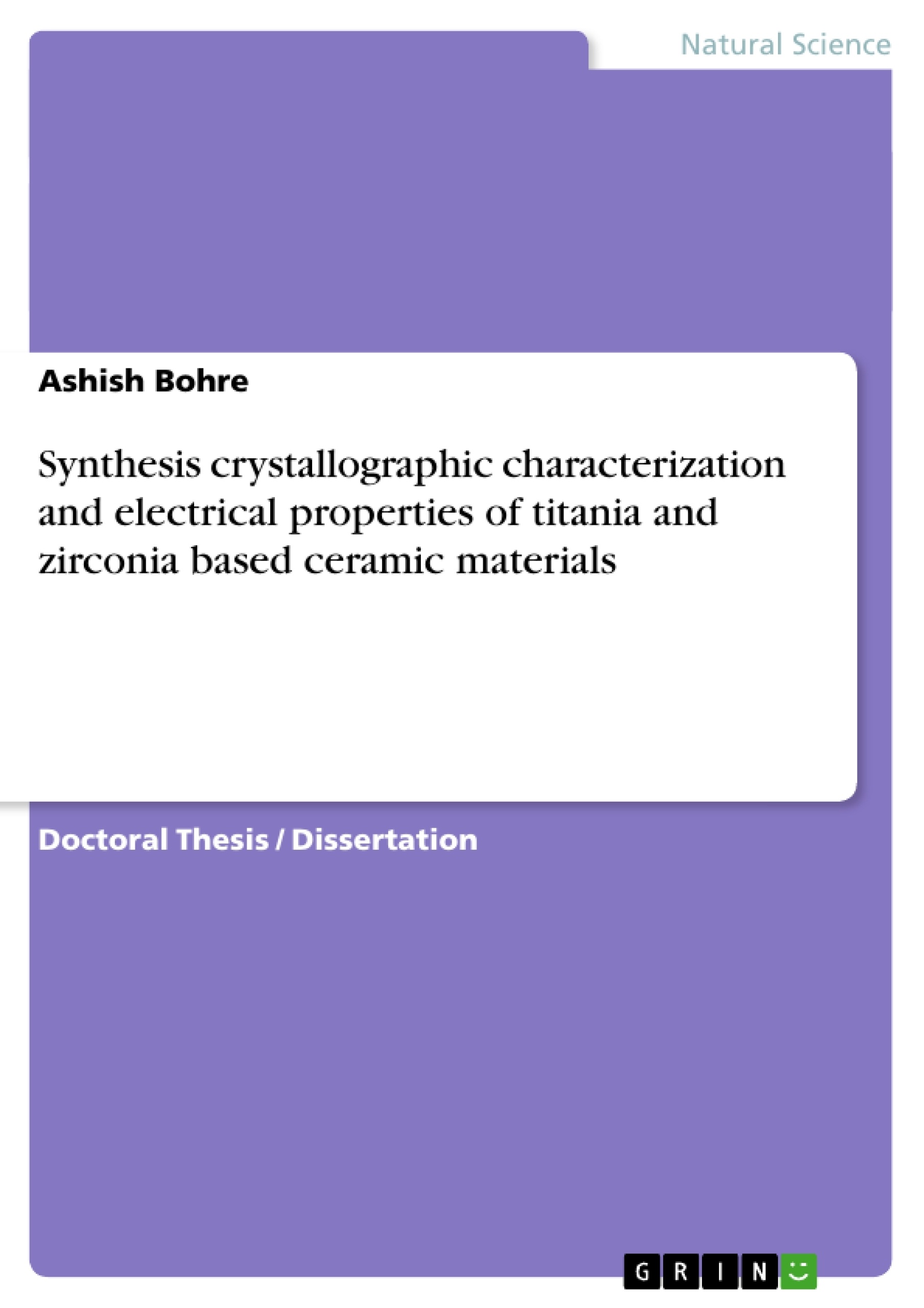Syntheses of all the three groups of materials (NZP, CZP and Perovskite) have been successfully carried out by solid state ceramic route resulting in the formation of single phase high density material in all the cases. Preliminary characterization was carried out by X-ray diffraction followed by complete crystal characterization by Rietveld method. Their crystal chemistry has been investigated using software’s like CRYSFIRE, Check cell, Winploter etc. Finally, structures have been refined to a satisfactory convergence using GSAS software. The structure model in each case has been given with the help of graphics software’s like PLATON, Crystal maker, Diamond and ORTEP etc.
Particle size calculation using Scherrer’s formula suggest that crystallite size along prominent reflections belongs to nano range in most of the synthetic phases. On the basis of results emerged after Rietveld refinement of each group of materials.
Inhaltsverzeichnis (Table of Contents)
- CHAPTER-1
- Introduction and Survey of Literature
- Definition
- Structure and properties of ceramic materials
- Advanced ceramics and their applications
- Scope of the present work
- Survey of relevant literature
- Substituted sodium zirconium phosphate (NZP)
- Substituted perovskites
- Substituted calcium titanate
- Substituted barium titanate
- Substituted zirconolites
- References
- CHAPTER-2
- Instrumental Techniques and Structure refinement
- X-ray Diffraction method
- Structure Determination
- Software applications in solving structures from powder X-ray diffraction pattern
- Indexing programs
- GSAS - Rietveld refinement
- Scanning Electron Microscopy (SEM)
- Energy Dispersive X-ray microanalysis (EDAX)
- Impedance Spectroscopy
- Infrared Spectroscopy
- Magic Angle Spinning NMR
- References
- CHAPTER-3
- Experimental procedures and data
- Methods of synthesis and materials characterization
- Characterization of ceramic phases
- XRD: Phase analysis and Rietveld refinement
- SEM/EDAX: Grain size, morphology and elemental analysis
- Impedance Study: Electrical behavior
- Dielectric measurements
- Infrared Spectroscopy
- MAS-NMR Spectroscopy
- Experimental data
- CHAPTER-4
- Results and Discussion
- Substituted Sodium Zirconium Phosphates (NZP)
- Antimony substituted sodium zirconium phosphate: Na1+xZr2-xSbxP3O12 (where x=0.05-0.2)
- Aluminum/ Chromium substituted sodium zirconium phosphate: Na1+xZr2-x (Al/Cr)xP3O12 (where x=0.1)
- Molybdenum substituted sodium zirconium phosphate: Na1-xZr2(PO4)3-x(MOO4)x (where x=0.1& 0.15)
- NZP ceramic waste forms:
- TYPE-I:Na1.49Zr1.56 Sn0.02 Fe0.28 Cr0.07Ni0.07P3012
- TYPE-II:Na1.35Ba0.14Zr1.56Sn0.02Fe0.28 Cro.07Ni0.07P2.86Si0.14012
- 0-35wt% WOx loaded waste forms
- Perovskites
- Calcium Yttrium Titanate: Ca 1-xYxTiO3 (where x=0.1-0.3)
- Calcium Iron Niobium Titanate: CaTi₁-x (Fe0.5Nb0.5)x3 (x=0.1-0.1.0)
- Substituted Barium Titanate: BaTi₁-(x+y)ZrxMnyO3 (0≤x<0.1, 0.01
- Zirconolite
- Substituted Calcium zirconium Titanate: iiCa1-xMxZrTi₂O7 (M=Y, La and x=0.1)
- Referencies
Zielsetzung und Themenschwerpunkte (Objectives and Key Themes)
This work aims to investigate the structural, electrical, and optical properties of various substituted ceramic materials. The study focuses on synthesizing and characterizing these materials to assess their potential for use in different applications.- Structure and properties of substituted ceramic materials
- Impact of substitution on the performance of ceramic materials
- Application of ceramic materials in various fields
- Synthesis and characterization techniques for ceramic materials
- Development of new ceramic materials with enhanced properties
Zusammenfassung der Kapitel (Chapter Summaries)
- Chapter 1 provides an introduction to ceramic materials, outlining their definition, structure, properties, and applications. It reviews the literature related to substituted sodium zirconium phosphate, perovskites, calcium titanate, barium titanate, and zirconolites.
- Chapter 2 describes the instrumental techniques and structure refinement methods used in the study. It explains X-ray diffraction, structure determination, software applications, scanning electron microscopy, energy dispersive X-ray microanalysis, impedance spectroscopy, infrared spectroscopy, and magic angle spinning NMR.
- Chapter 3 details the experimental procedures and data analysis methods used for synthesizing and characterizing the ceramic materials. It includes methods of synthesis, XRD analysis, SEM/EDAX analysis, impedance studies, infrared spectroscopy, and MAS-NMR spectroscopy.
- Chapter 4 presents the results and discussion of the study. It focuses on the structural, electrical, and optical properties of various substituted ceramic materials, including sodium zirconium phosphates, perovskites, and zirconolites.
Schlüsselwörter (Keywords)
This work revolves around the synthesis, characterization, and properties of various substituted ceramic materials, including sodium zirconium phosphate, perovskites, and zirconolites. The research focuses on understanding the impact of substitution on the structure, electrical conductivity, and optical properties of these materials. Key terms include ceramic materials, substitution, structure determination, Rietveld refinement, impedance spectroscopy, infrared spectroscopy, and MAS-NMR spectroscopy.- Quote paper
- Ashish Bohre (Author), 2012, Synthesis crystallographic characterization and electrical properties of titania and zirconia based ceramic materials, Munich, GRIN Verlag, https://www.hausarbeiten.de/document/233302


